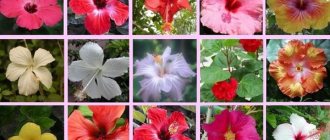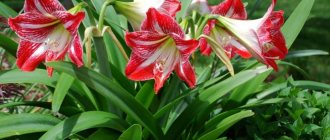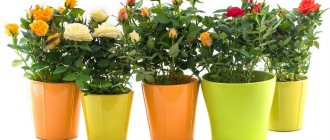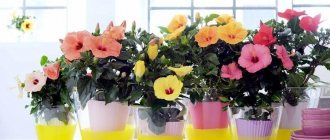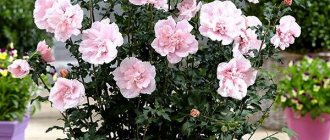Caring for your home rose
The flowering of any plant is the result of proper maintenance. It seems to thank us for caring. And, on the contrary, it begins to rebel when we make mistakes. We put the violets in a draft or in the bright sun, and then we wonder: why do the leaves of violets curl?
Indoor hibiscus can grow well, stretch out and add foliage for years, but not produce flowers. Sometimes an unfortunate bud will appear and fall off. That's all the joy. Let's reveal the secrets of keeping Chinese rose.
1. Grows well in the shade. But for good flowering, the pot needs to be placed in a bright room. Hide from direct sunlight.
2. Hibiscus will be grateful if you take it out into the fresh air in the summer. Place it on the balcony, for example, or in the garden. The place should be bright, protected from the wind.
3. Rosan doesn't like heat. In summer it needs to be sprayed every day or even twice a day. Water regularly and abundantly as soon as the top layer of soil dries out. If you don't water it on time, the plant will drop leaves and buds.
4. Hibiscus loves breathable and moisture-absorbing soil. Watered - carefully loosened the substrate so that air could flow freely to the roots.
5. Rozan likes feeding. During the period of active growth (spring-summer), fertilizers are applied approximately three times a month. Complex mineral or slightly concentrated organic is suitable.
6. In winter, the plant is watered and fed less often. It is enough to apply fertilizer once a month.
These are the basic rules of care. But, as practice shows, observing them is not enough for lush flowering.
Flower growers' mistakes
In shops and train stations, where hardly anyone takes rose gardening seriously, there are blooms. And regular. But in apartments and houses there are problems with this. And you water it, and feed it, and put it in the sun - nothing. Why doesn't indoor hibiscus bloom? The thing is that when keeping at home, two basic requirements are often not met:
In autumn and winter, send hibiscus to rest.
It’s like we’ve been running around it all year. But you don’t need to do this. Flower buds are formed at a temperature of about fifteen degrees. It's cold outside, there's no heating yet - that's what you need. When the batteries are turned on, it is advisable to move the hibiscus to the coolest place in the house. You can even go into the shade. And there is no need to interfere with Rozan’s rest. Disturb it with fertilizing, frequent watering, and spraying.
In February we move the flower closer to light and warmth. Gradually increase the amount of watering and fertilizing.
Before waking up, prune your hibiscus.
Flower buds appear on young branches. And to stimulate their growth, the plant needs to be pruned. In addition, with the help of pruning, you can form a beautiful tree shape.
Here are the two main conditions for hibiscus to bloom (if, of course, the other care rules are followed).
Let's prevent errors:
1. If a hibiscus produces buds in a cold room, then when the climate changes, it will drop them plus some of the foliage. The moment of awakening was missed. Then new buds will appear and the foliage will grow. But it is better to have time to take the rose to the place where it blooms.
2. If the hibiscus does not have enough light, heat, fertilizer or water, it will drop its buds. When bringing a plant out of hibernation, try to immediately provide it with proper care.
3. When overfeeding roses with nitrogen fertilizers, there will be a lot of lush foliage. But only.
According to the teachings of Feng Shui, hibiscus is a representative of the element of fire. It is ideal for very reserved and rational individuals. The Chinese rose harmonizes space and helps people find contact with each other.
Like all other indoor flowers, hibiscus purifies the air and normalizes the ratio of gases in it. Only prejudices and superstitions force gardeners to abandon certain plants in their apartments. That's why you can't grow violets at home? Such grateful and beautiful flowers?
Malvaceae family.
Hibiscus species
- Chinese hibiscus is an evergreen shrub, growing at home from 70 to 1.5 m tall. The leaves are entire, ovate or lanceolate, with a serrated or wavy edge on long petioles. Hibiscus blooms quite easily with good care with large flowers, up to 12 cm in diameter. Flowering can be abundant and long - from spring to autumn, although the flowers do not last long - about two days. The flowers come in different shades - orange, yellow, red, pink or white, as well as in different shapes - single or double.
- There are varieties with variegated leaves, for example Hibiscus rosa-sinensis var. cooperi Hibiscus Cooper (in the first photo) - it has elongated leaves (up to 10-12 cm long and 3 cm wide) and cream and pink specks on a light green background. Very good branching.
- Linden hibiscus Hibiscus tiliaceus is an evergreen tree with linden-shaped leaves, round-oval, about 8-15 cm in diameter, simple or lobed, usually serrated. The flowers are large, five-petalled, similar to abutilon flowers, yellow in the morning, turning red in the evening. There is a variegated form with variegated leaves.
Hibiscus is a wonderful plant to grow at home, suitable for beginner gardeners and easy to bloom at an early age.
When and how does it bloom
When favorable conditions are created, the rose blooms in early May and pleases with buds until late autumn. In general, the duration depends on the growing conditions.
Chinese rose - home care and propagation
Types of flowers - double or simple. The buds of the rose are narrow; as the petals open, they become cup-shaped.
Important! When flowering occurs, the frequency and abundance of crown moisture increases. Mineral complex fertilizers are applied every 2 weeks.
Hibiscus - home care
Hibiscus is one of the few plants that grow well at home, turning over the years into a spreading shrub that can decorate a living room, bedroom, staircase, hallway, and if it has enough light, it can delight with annual flowering. Hibiscus is completely safe for children and animals - it has neither sharp spines nor poisonous milky juice.
Temperature
Hibiscus is thermophilic, although it is happy with any temperature, the optimal temperature for growth is 20-25°C; at higher temperatures, flowers fade faster, but in general, hibiscus easily adapts to any conditions. In the summer, it is better to take the plant out into the garden or onto the balcony, into fresh air, but the place should be protected from the wind and slightly shaded. In winter, a coolness of 15-18°C is desirable; if you leave the pot on a glazed (insulated) balcony, you can keep it until mid-autumn, until the temperature drops to +10°C, but watering is very strict. The decrease in temperature in winter is due to a decrease in light; the darker the plant, the more important it is to lower the temperature so that the bushes do not lose leaves. If you can't keep it cool, just install lamps nearby.
Lighting
Hibiscus loves bright diffused light, for flowering at least 4 hours of direct sun in the morning or evening, and very good, openwork light in the midday hours. Small hibiscus grow on windowsills, but over time they don’t have enough space here and have to move the pots into the room. In this case, it is best to place hibiscus near a south window.
The light requirements of roses are only in terms of flowering; if a deciduous tree is enough for you, the pot can be placed in diffused light or light partial shade (on the north side), perhaps occasionally it will bloom with solitary flowers. But if you want constant abundant flowering, you need a lot of light, supplementary lighting on cloudy days in winter, when the temperature is above 18°C. LED or fluorescent lamps are suitable for additional lighting. To illuminate a tree from 80 cm to 1.2 m in height, you need approximately 2-3 LED bulbs with a regular base, 15-20 W, placed on different sides of the crown.
Cooper's hibiscus is more demanding of light, it turns its shoots clearly towards the light source, so it needs to be illuminated or periodically turned in different directions on the windowsill.
Watering and air humidity
Hibiscus has a large mass of leaves, the leaf surface has a thin epidermis, so it evaporates moisture very actively. This is why you should avoid leaving plants in the heat; you may simply not have time to water them. And in the warm season you need to water often, in spring and summer almost every day. Although the frequency of watering is determined not by the days of the week, but by the speed at which the soil dries out - it should have time to dry in the upper third of the pot, and remain slightly moist inside.
- When it gets colder, moisture evaporation is sharply reduced and watering should also become less frequent - reduce watering in rainy, cool weather in the summer. And don’t forget to switch to a new irrigation system with the heating turned on in the fall and the end of the heating season in the spring.
Hibiscus easily tolerates dry air; if you are an idealist, then know that this plant likes air humidity of 50-70%. If the hygrometer reading is below 30%, you need to start spraying 2-3 times a day. If the pot is located next to the radiator, in winter you need to cover it with a damp terry towel or sheet. While the plants are small, they can be periodically carried into the bathroom under a warm or hot shower to wash off the dust. Avoid using leaf polish.
More photos of Hibiscus
Feeding
Feeding begins 1.5-2 months after transplantation. It is necessary to give a complex fertilizer that contains nitrogen, phosphorus and potassium in equal parts or slightly less nitrogen (for example, Fertika-lux). Large doses of nitrogen, like organic matter, cause rapid growth of foliage and delay flowering. It is very good if the fertilizer contains minerals that are no less important for flowering, for example, boron and zinc, as well as molybdenum, copper, and manganese. Fertilizing can be carried out only during the period of active growth and flowering with an interval of two weeks. If in winter the hibiscus continues to grow at home in warmth and good light, and perhaps even blooms, then you can feed it once a month. There are a lot of good fertilizers, choose those that are intended for flowering plants.
- At the beginning of spring, you can carry out foliar feeding: dilute 2 g of boric acid powder, 1 g of zinc sulfate, 2 tablets of succinic acid in 5 liters of water and spray all the leaves in the evening. Repeat in a month.
- From May to August, you can fertilize with potassium humate: 1 teaspoon of potassium humate per 5 liters of warm water. Water once a month.
Transfer
Young hibiscus need to be replanted annually in fresh soil. Often you have to enlarge the pot if the root ball no longer fits in the old one. The growth rate of hibiscus depends on the conditions; the better the microclimate in your home, the more vigorously the hibiscus grows, and the better the light, the more responsive it blooms. Along with growth in height, the hibiscus thickens the trunk; at the age of ten it is about 2.5-3 cm thick in diameter. The root system also grows; it is quite powerful and dense; a large tree needs a large flowerpot (15-20 l) or a small wooden tub.
If the conditions in the apartment are such that hibiscus does not grow in autumn and winter, then perhaps there will be no need to enlarge the pot in a year.
What to plant hibiscus in: a round pot, plastic or ceramic, with large holes in the bottom. If the tub or large flowerpot does not have holes for water drainage and there is no tray provided, you need to make very high drainage (from expanded clay or polystyrene foam, 2 cm pieces). If in a regular pot it is about 2-5 cm (from the size), then in a tub without holes it is all 10 cm.
- Soil for young hibiscus: 1 part turf soil, 1 part leaf soil, 1 part fine gravel or pebbles (3-5 mm), 1/2 part humus.
- Soil for adult (over 5 years old) hibiscus: 2 parts turf soil, 1 part humus, 1 part gravel or pebbles (3-5 mm), 1/3 part vermiculite.
- Universal option: 5 liters of Terra Vita living soil peat soil, 1 liter of vermiculite, 1 liter of small pebbles (3-5 mm) + 100-200 g of vermicompost.
Surely you have seen somewhere in an office or kindergarten a Chinese rose planted in roadside soil, dense and cemented over the years. Indeed, hibiscus are not too picky about soil, but this applies only to our “Russian” hibiscus obtained from cuttings from my grandmother. And if you happened to buy a Dutch copy, it will not tolerate such treatment.
Dutch or Polish hibiscus grown in a greenhouse are more demanding to care for. They need the right soil, well-drained, loose, easily absorbing water and quickly evaporating it. They prefer a slightly acidic reaction - pH 5.5-6. Dutch (store-bought) hibiscus do not tolerate dampness or dryness!
Hibiscus soil, replanting and fertilizing
Usually the flower is sold in compact form, where they are treated with special preparations that slow down growth, but at home, especially after transplanting into new soil, hibiscus begins to grow actively.
In the spring, simultaneously with pruning, hibiscus are replanted or transferred to fresh substrate; young plants annually, adults - as needed. For large specimens, the top layer of soil is changed annually. Transshipment while preserving the earthen coma is carried out at any time of the year.
Any nutrient substrate is suitable for transplanting hibiscus. I usually take two-thirds of the garden soil, but not black soil, and add universal soil for indoor crops. You can add turf or humus soil. Since the Chinese rose needs good watering, to avoid stagnation of water, good drainage from expanded clay at the bottom of the pot is necessary.
With each transplant you need to take a larger pot, but not much. In a pot that is too large, the rose will begin to grow, but will stop blooming. For a large specimen, you just need to change the top layer of soil.
When replanting, as long as the size of the earthen ball allows, I shake off the old soil from the roots, especially if it is too wet. You don’t have to completely remove the soil from the roots and you don’t have to cut the roots themselves if there is no suspicion of their rotting.
Hibiscus propagation
Hibiscus is propagated by cuttings. Rooting itself is not a problem - at any time of the year, as long as it is warm and light. And formative pruning is carried out at any time during the growth period; you can repeatedly pinch the ends of the shoots.
The cuttings are rooted in water; if the cutting is cut long, you need to tear off some of the lower leaves, you can leave 1-2 leaves at the top. When the cuttings grow roots of 3-4 cm, transplant them into small pots with a diameter of 8-10 cm. It is even better to plant the cuttings in small plastic transparent cups. When a large accumulation of roots becomes noticeable through the wall, you can transplant it into a suitable pot.
You can root cuttings in pure vermiculite or a mixture of vermiculite and universal peat soil. But the substrate must be sterilized.
Personal experience, Marla: “I plant hibiscus cuttings in a peat tablet, first dipping it in the root, so after two weeks the roots stick out from it. Then I immediately transplant it into a pot. I cut off almost all the leaves, leave one or two, if the second one is large, then I cut it in half so that less moisture evaporates and does not waste energy on it. By the way, cuttings from young branches always form roots better and faster.”
Decorative flower propagation
Chinese rose is propagated by two methods, cuttings and seeds.
By cuttings . For this type of propagation, it is better to take layering from a young hibiscus plant. It can be placed both in soil and in water. To propagate in water, you need to place the cuttings in a dark glass and cover with a cap to increase air humidity. After a month, you can already replant it in the ground if a root has appeared. The soil must contain peat and sphagnum moss. When planting cuttings directly into the ground, you must first remove all leaves except the top two and prepare a mixture of peat and coarse sand.
Seeds . Hibiscus seeds should be planted in peat and sand soil from January to March. Before planting the seeds, you need to soak them in Epin. After planting, cover with film or glass (a kind of greenhouse) and maintain the temperature at about 26 degrees. When growing hibiscus seeds, the greenhouse should be ventilated and the soil should be sprayed.
The first option is recommended for a novice plant grower - it is simpler and has advantages. When propagated by cuttings, firstly, the characteristics of the mother variety will be preserved. Secondly, hibiscus will bloom in the first year after planting, in contrast to seed propagation (only after 2-3 years).
Growing problems
If the soil contains a lot of draining particles (pebbles or gravel, vermiculite), good holes in the bottom of the pot and bottom drainage, then the pot can be taken with a small margin. But if the soil is dense, forming a dense lump after watering, there is a risk of flooding the plant in a large pot.
With excessive watering or when the earthen ball dries out, flowers and buds may also fall off, but the main indicator is the condition of the leaves. If the hibiscus leaves begin to turn yellow, you need to check:
- soil in a pot, digging it up to a depth of 5-7 cm; if it is damp, you flood the plant; if it is dry and the pot has become very light, then you have dried it out
- Please note that the leaves are elastic or drooping: leaves may wilt due to overdrying, flowers instantly dry out and fall off, but after watering turgor (elasticity) is restored
- if the top of the cutting or the ends of the branches droop, most likely you are flooding the plants
- pay attention to the nature of the spots - if they are yellow spots in the middle of the leaf, marbled yellowing without clear boundaries - look for pests: mites, scale insects, scale insects
Store-bought hibiscus may be more capricious in terms of rearrangement: during the set of buds and flowering, do not move or turn, as this causes the buds or flowers to fall off.
Cuttings of Hibiscus Lipofolia
Hibiscus appeared in botanical gardens in Europe in the eighteenth century. The charming, unpretentious, tropical guest quickly took root and found admirers. In nature, it is deciduous and evergreen, herbaceous and tree-like. Today, hundreds of varieties are known to decorative floriculture. Each of them is interesting in its own way. But the Chinese species has taken root most of all, with large dark green leaves and red double flowers. It is often called Chinese rose.
The plant develops quickly. With good care it turns into a beautiful tree, covered with flowers all summer. These are the ones we often see in the lobbies of hotels, hospitals, and train stations. But it’s impossible to achieve flowering at home. We cherish, we cherish - but nothing. Why doesn't hibiscus bloom?
Possible problems in growing a rose tree
The rose in the house is an unpretentious tree and quite resistant to diseases. Their appearance is a consequence of improper care.
Improper care can lead to withering of the entire bush and its death.
Most common problems:
- Drops buds and leaves - temperatures are too low, not higher than +10 °C.
- The leaves are turning yellow. This happens due to abundant soil moisture. If the color of most of the crown changes, only replanting can save the bush.
- The rose is drying. The reason is frequent drying out of the soil.
- The leaves are falling. The reason is the lack of sunlight.
Another common problem is that the plant does not bloom. Reasons why the bush cannot bloom:
- high indoor temperatures in winter;
- insufficient lighting during the growing season.
You can correct the situation by organizing rose care.
Pests
The bush can be affected by aphids or spider mites. Treatment is to treat the rose with soapy water. In advanced situations, insecticides are used.
Hibiscus wilts
The reasons are lack of moisture or replanting of an old bush, poor condition of the root system. The bush is replanted, the roots are carefully checked, bad and weak roots are removed.
Additional Information! When transplanting into the ground, it is recommended to add vermiculite.
Caring for your home rose
The flowering of any plant is the result of proper maintenance. It seems to thank us for caring. And, on the contrary, it begins to rebel when we make mistakes. We put the violets in a draft or in the bright sun, and then we wonder: why do the leaves of violets curl?
Indoor hibiscus can grow well, stretch out and add foliage for years, but not produce flowers. Sometimes an unfortunate bud will appear and fall off. That's all the joy. Let's reveal the secrets of keeping Chinese rose.
1. Grows well in the shade. But for good flowering, the pot needs to be placed in a bright room. Hide from direct sunlight.
2. Hibiscus will be grateful if you take it out into the fresh air in the summer. Place it on the balcony, for example, or in the garden. The place should be bright, protected from the wind.
3. Rosan doesn't like heat. In summer it needs to be sprayed every day or even twice a day. Water regularly and abundantly as soon as the top layer of soil dries out. If you don't water it on time, the plant will drop leaves and buds.
4. Hibiscus loves breathable and moisture-absorbing soil. Watered - carefully loosened the substrate so that air could flow freely to the roots.
5. Rozan likes feeding. During the period of active growth (spring-summer), fertilizers are applied approximately three times a month. Complex mineral or slightly concentrated organic is suitable.
6. In winter, the plant is watered and fed less often. It is enough to apply fertilizer once a month.
These are the basic rules of care.
Diseases and pests
During cultivation, hibiscus owners have questions, for example, why do the leaves curl? The answer lies in the pathological process caused by pests, or rather aphids. Leaves may be sticky for the same reason.
There are other diseases and pests that lead to the death of the plant:
- falling of leaves and flowers;
- death of young shoots;
- lack of flowering;
- formation of spots on leaves;
- wilting and drying of foliage.
If the regime of spraying and washing the plant is not followed, spider mites, thrips and whiteflies will appear on it.
Flower growers' mistakes
In shops and train stations, where hardly anyone takes rose gardening seriously, there are blooms. And regular. But in apartments and houses there are problems with this. And you water it, and feed it, and put it in the sun - nothing. Why doesn't indoor hibiscus bloom? The thing is that when keeping at home, two basic requirements are often not met:
In autumn and winter, send hibiscus to rest.
It’s like we’ve been running around it all year. But you don’t need to do this. Flower buds are formed at a temperature of about fifteen degrees. It's cold outside, there's no heating yet - that's what you need. When the batteries are turned on, it is advisable to move the hibiscus to the coolest place in the house. You can even go into the shade. And there is no need to interfere with Rozan’s rest. Disturb it with fertilizing, frequent watering, and spraying.
In February we move the flower closer to light and warmth. Gradually increase the amount of watering and fertilizing.
Before waking up, prune your hibiscus.
Flower buds appear on young branches. And to stimulate their growth, the plant needs to be pruned. In addition, with the help of pruning, you can form a beautiful tree shape.
Here are the two main conditions for hibiscus to bloom (if, of course, the other care rules are followed).
Let's prevent errors:
1. If a hibiscus produces buds in a cold room, then when the climate changes, it will drop them plus some of the foliage. The moment of awakening was missed. Then new buds will appear and the foliage will grow. But it is better to have time to take the rose to the place where it blooms.
2. If the hibiscus does not have enough light, heat, fertilizer or water, it will drop its buds. When bringing a plant out of hibernation, try to immediately provide it with proper care.
3. When overfeeding roses with nitrogen fertilizers, there will be a lot of lush foliage. But only.
According to the teachings of Feng Shui, hibiscus is a representative of the element of fire. It is ideal for very reserved and rational individuals. The Chinese rose harmonizes space and helps people find contact with each other.
Like all other indoor flowers, hibiscus purifies the air and normalizes the ratio of gases in it. Only prejudices and superstitions force gardeners to abandon certain plants in their apartments. That's why you can't grow violets at home? Such grateful and beautiful flowers?
Hibiscus in the house: signs and superstitions
How many contradictions are hidden in such a popular flower as the Chinese Rose or Hibiscus! The possible influence on a person may be different, but to a greater extent superstitions and signs are associated with people’s imagination and have nothing to do with the real state of affairs. Hibiscus is the flower of death, as many “knowledgeable” people claim, and if flowering occurs at the wrong time, then a misfortune will happen to someone close to you. No one knows where this belief came from, but many are afraid to keep a luxurious tree with spectacular buds at home, and grow the plant in offices and public places.
There is another opinion - Hibiscus carries powerful energy, invigorates creativity, activates the circulation of active matter around itself, because the flower belongs to the sign of Fire. A plant with a masculine principle restores the flame of love in spouses who have been married for many years. In many eastern countries, Hibiscus is considered a talisman for the hearth and a talisman for good luck.
Which version is closer? It is up to each person to decide, taking into account his beliefs and character. If you want to have a Chinese rose, but there are concerns about bad signs, you can place a flowerpot with Hibiscus at work: a well-groomed, beautiful tree with bright foliage and large flowers will certainly delight colleagues and visitors.
Indoor hibiscus is an evergreen plant with spectacular, bright green foliage and luxurious, large buds. Even without flowers, the tree remains decorative. If you follow the rules, you can enjoy the luxurious blooms of the Chinese rose for several months.
More useful recommendations for gardeners about the features of caring for Chinese roses can be found in the following video:
Chinese rose: care and growing from seeds
Already in March, the first buds of hibiscus begin to appear , and successive flowers adorn the crown of leaves until late autumn .
| photo | description | young plant |
| Red double hibiscus / “Chinese rose” The most common species in our indoor and greenhouse culture is the so-called Chinese rose (Hibiscus rosa-sinensis). This is a flower with large, pure double red flowers, which is considered to be native to the Malay Archipelago. This is a very strong and strong plant that can be used for grafting varietal hibiscus. If you correctly form the crown of a hibiscus, not allowing it to turn into a “tree,” it will delight you with abundant flowering every year, being an undisputed decoration of the collection. | 250rub. rooted | |
| Terry peach hibiscus A large double flower of a delicate peach color, with sharp teeth on the edges of the petals, which give the flower’s shape even more charm. | 650 rub. rooted | |
| Hibiscus pink terry Multi-petaled double flower, the color is more saturated in the middle of the flower and lighter towards the edges. | 650 rub. rooted | |
| Hibicus soft pink with beige border A large flower of very delicate tones: most of the petals are soft pink and the edge is soft beige. | 650 rub. rooted | |
| Hibiscus Yellow Orange Pink Hibiscus / hot pink with orange border Large flower. The flower has a very bright, contrasting color: a neon pink middle and a bright orange wide border. | 650 rub. rooted | |
| Hibiscus Blue Diamond A double flower with a diameter of 13-14 cm of an unusual lilac-blue color. | 1500 rub. | |
| Hibiscus Cajun cocktail NEW! | coming soon | |
| Hibiscus Green Elf Flowers up to 16 cm, regular plate-shaped, bright mustard color with yellow veins. The leaves are not large. Slow growing. | 1500 rub. | |
| Hibiscus Love Potion The double flower is huge, 21-25 cm, white. In cloudy weather it may have a yellowish-cream tint. The flower lasts three (!) days. Early abundant flowering. | 1500 rub. | |
| Love Story/Love story Double hibiscus Love Story: its white veined pattern flows like rivulets over wavy, bright crimson petals. | 2000 rub. | |
| Hibiscus Midnight Serenade (NEW!) Large flower. The center of the flower is a mixed burgundy-raspberry color, the edge is yellow-orange. | 1000 rub. | |
| Hibiscus Milleniem Superstar Terry hibiscus, flower diameter 16 cm. The dark red, almost burgundy core turns into lilac, then into soft pink. Along the edge there is a wide white border. | 1000 rub. | |
| Hibiscus Vodoo Magik A corrugated flower with a diameter of 15-17 cm, readily blooms and branches well. Not a spreading variety. | 1000 rub. | |
| Hibiscus Yoda Simple and very double flowers, quite large, rich dark brown in the center, gradually turning into orange-yellow at the end of the petal. | 1000 rub. | |
| Hibiscus White Diamond Simple grayish-purple flowers and a large number of white streaks and spots on the petals. The variety reacts to temperature and varies. | 1000 rub. |
Hibiscus appeared in botanical gardens in Europe in the eighteenth century. The charming, unpretentious, tropical guest quickly took root and found admirers. In nature, it is deciduous and evergreen, herbaceous and tree-like. Today, hundreds of varieties are known to decorative floriculture. Each of them is interesting in its own way. But the Chinese species has taken root most of all, with large dark green leaves and red double flowers. It is often called Chinese rose.
The plant develops quickly. With good care it turns into a beautiful tree, covered with flowers all summer. These are the ones we often see in the lobbies of hotels, hospitals, and train stations.
Caring for your home rose
The flowering of any plant is the result of proper maintenance. It seems to thank us for caring. And, on the contrary, it begins to rebel when we make mistakes. We put the violets in a draft or in the bright sun, and then we wonder: why do the leaves of violets curl?
Indoor hibiscus can grow well, stretch out and add foliage for years, but not produce flowers. Sometimes an unfortunate bud will appear and fall off. That's all the joy. Let's reveal the secrets of keeping Chinese rose.
1. Grows well in the shade. But for good flowering, the pot needs to be placed in a bright room. Hide from direct sunlight.
2. Hibiscus will be grateful if you take it out into the fresh air in the summer. Place it on the balcony, for example, or in the garden. The place should be bright, protected from the wind.
3. Rosan doesn't like heat. In summer it needs to be sprayed every day or even twice a day. Water regularly and abundantly as soon as the top layer of soil dries out. If you don't water it on time, the plant will drop leaves and buds.
4. Hibiscus loves breathable and moisture-absorbing soil. Watered - carefully loosened the substrate so that air could flow freely to the roots.
5. Rozan likes feeding. During the period of active growth (spring-summer), fertilizers are applied approximately three times a month. Complex mineral or slightly concentrated organic is suitable.
6. In winter, the plant is watered and fed less often. It is enough to apply fertilizer once a month.
These are the basic rules of care. But, as practice shows, observing them is not enough for lush flowering.
Flower growers' mistakes
In shops and train stations, where hardly anyone takes rose gardening seriously, there are blooms. And regular. But in apartments and houses there are problems with this. And you water it, and feed it, and put it in the sun - nothing. Why doesn't indoor hibiscus bloom? The thing is that when keeping at home, two basic requirements are often not met:
In autumn and winter, send hibiscus to rest.
It’s like we’ve been running around it all year.
But you don’t need to do this. Flower buds are formed at a temperature of about fifteen degrees. It's cold outside, there's no heating yet - that's what you need. When the batteries are turned on, it is advisable to move the hibiscus to the coolest place in the house. You can even go into the shade. And there is no need to interfere with Rozan’s rest. Disturb it with fertilizing, frequent watering, and spraying.
In February we move the flower closer to light and warmth. Gradually increase the amount of watering and fertilizing.
Before waking up, prune your hibiscus.
Flower buds appear on young branches. And to stimulate their growth, the plant needs to be pruned. In addition, with the help of pruning, you can form a beautiful tree shape.
Here are the two main conditions for hibiscus to bloom (if, of course, the other care rules are followed).
Let's prevent errors:
1. If a hibiscus produces buds in a cold room, then when the climate changes, it will drop them plus some of the foliage. The moment of awakening was missed. Then new buds will appear and the foliage will grow. But it is better to have time to take the rose to the place where it blooms.
2. If the hibiscus does not have enough light, heat, fertilizer or water, it will drop its buds. When bringing a plant out of hibernation, try to immediately provide it with proper care.
3. When overfeeding roses with nitrogen fertilizers, there will be a lot of lush foliage. But only.
According to the teachings of Feng Shui, hibiscus is a representative of the element of fire. It is ideal for very reserved and rational individuals. The Chinese rose harmonizes space and helps people find contact with each other.
Like all other indoor flowers, hibiscus purifies the air and normalizes the ratio of gases in it. Only prejudices and superstitions force gardeners to abandon certain plants in their apartments. That's why you can't grow violets at home? Such grateful and beautiful flowers?
Description:
The genus of hibiscus belongs to the family. Malvaceae and has over 250 species. Southeast Asia is considered the homeland of hibiscus, but they grow freely in Africa and America.
Swamp hibiscus 'Tsar Bell'
Photo by Olga Donskaya
In America, they form entire thickets, lushly covered with flowers, in wet floodplain meadows. Because of their great love for moisture, they are called “swamp mallow.” In Hawaii, hibiscus is considered the national plant and is called the “flower of beautiful women.” In Brazil, the hibiscus diophyta grows, called “princess earrings”. It has split petals and a long peduncle on which it sways gracefully, truly reminiscent of an exquisite earring.
Hibiscus in the places where they grow serve not only for decorative purposes. Young leaves and shoots are eaten as vegetables. Seeds, leaves, fruits, roots are used in medicine. The seeds are used to make necklaces. The flowers are used to make black hair dye and purple dye for the food industry. Pieces of dry fruits of Hibiscus sabdariffa
(Hibiscus sabdariffa) is an essential component of fruit teas. It goes on sale under the names “Hibiscus tea”, “Mallow tea”, “Sudanese rose”, “Hibiscus”.
Our best known hibiscus, cultivated as a houseplant, is the Chinese rose.
(Hibiscus rosa-sinensis), or Chinese rose from Southeast Asia.
Edible hibiscus
is grown as a vegetable herb in the southern regions . In temperate climates, okra can be grown in greenhouses and greenhouses.
| Syrian hibiscus , or ketmia , or Syrian rose — Hibiscus syriacus Native to China and Western Asia. It grows in open ground in the Caucasus, Central Asia and Moldova, Crimea, and Kuban. This is a deciduous shrub up to 5-6 m high. It is distinguished by bright green ovate leaves up to 10 cm long. Its flowers are single, smaller than those of the “Chinese rose” and of a wide variety of colors from white to crimson, sometimes bicolor, simple and double. They are grown as bushes or small standard trees. Hibiscus loves a lot of light, warmth and moisture. Then it blooms long and luxuriantly from the second half of summer until frost. It can tolerate partial shade, but then it blooms worse. Propagated by seeds and semi-lignified cuttings. Terry varieties are propagated only vegetatively. Seeds are stored in paper bags in a cool, dry place. When stored this way, the seeds remain viable for 3 years. Laboratory germination is 94 - 96%, soil germination is 86 - 89%. The seeds do not have organic dormancy and do not need stratification. Planting depth is 2 - 3 cm. Seeds are sown directly into the ground or into a nursery. Seedlings bloom as early as August of the first year and bloom throughout the fall. Plants are very responsive to fertilizer. In central Russia, this plant is easier to grow as a seasonal annual, or to keep in a bright and cool room in winter. Can be used as an indoor plant. Photo by Kirill Tkachenko |
| Hibiscus hybrid — Hibiscus hybrida It appeared in culture recently. Its flowers are similar to those of the “Chinese rose”, its leaves resemble maple leaves. During the winter, the upper part of the plants dies off. Powerful root tubers remain in the ground to overwinter. This plant is not demanding on soil and is quite drought-resistant. It grows well only in open sunny places in the garden. Propagated by dividing bushes or cuttings. When propagated by seed, it blooms within 2-3 years. The plant itself is quite frost-resistant; in Russia it can winter in open ground at the latitude of Voronezh under a layer of snow of 20-30 cm and a shelter of dry leaves. Read Andrey MILYAEV (Voronezh) “Hybrid herbaceous hibiscus” |
| Hibiscus trifoliata — Hibiscus trionum L. A herbaceous plant native to the North. and Center. Africa. Currently, the plant is widespread in all areas of irrigated agriculture, where it is found in cotton crops, row crops, pastures and wastelands. It also grows in steppe and forest-steppe regions of the European part of Russia. Prefers loose sandy soils, warmth and moisture. The root is taproot, the stem is straight, branched, 20-80 cm high. The leaves are alternate, tripartite, petiolate, pubescent. The flowers are pale yellow with a purple center and are up to 4 cm in diameter. |
Features of caring for hibiscus at home: what to feed, how to care for it in winter?
They open in the morning for only a few hours, and in the afternoon they close. Nevertheless, the flowering period of this plant lasts more than a month, since new buds are formed in the axil of each leaf. If you create the right conditions, flowers will appear every day. After the corolla falls off, a swollen fruit forms on the peduncle.
It is a five- or multi-seeded hairy black capsule with kidney-shaped or oval-heart-shaped dark seeds. Weight of 1000 seeds is 3-4 g. Maximum fertility is up to 15 thousand seeds, which germinate from a depth of up to 5 cm. The development cycle from seedling to the first fruits is 60-70 days. Seeds spill out of the boxes and litter the soil. The germination rate of freshly shed seeds is low. The minimum germination temperature is 5-6°C. Cotyledons are 7-9 mm long, 6-8 mm wide, rounded. The viability of seeds lasts up to 5-7 years. In places with warm climates, hibiscus begins to grow like a weed.
Dried shoots with unusual fruits are good in dry bouquets. There are several varietal forms on sale. They are sown in March for seedlings or in May in open ground. The soil should be loose and nutritious.
Photo by Evgenia Maksimenko
Read: R. GALUSHKO, A. YAROSLAVTSEV “THE SMILE OF THE TROPICS - HIBISCUS”
